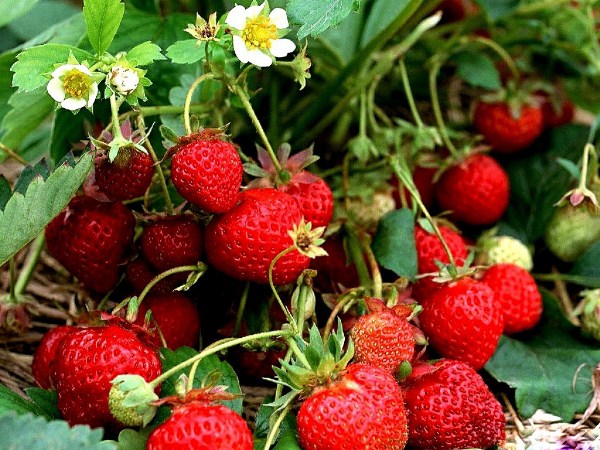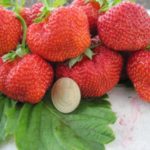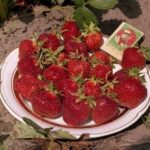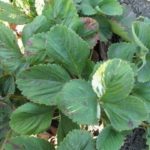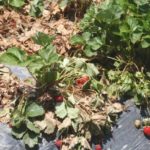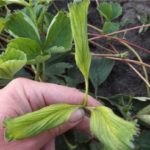Strawberries are a favorite baby treat. A rare summer resident does not cultivate at least a small plot with this berry on his plot. Strawberries can be small-fruited (alpine) and large-fruited (gardening). The first is a cultivated forest species (Fragaria vesca var. Alpina). The second in the wild form is not found. It is about her and will be discussed in the material.
Table of contents
- Garden strawberries and strawberries: feel the difference!
- How to choose a variety for cultivation in the garden?
- How to prepare planting material?
- Propagation of strawberries with mustache and horns, planting and care
- Diseases and pests, prevention in spring and autumn
- Protection of strawberries from heat and frost
- Conclusion
Garden strawberries and strawberries: feel the difference!
The type of strawberry garden is otherwise called the strawberry pineapple, from the Latin name Fragaria ananassa. Of course, this plant has nothing to do with pineapples. Its occurrence is due to the process of free-pollination between the Chilean and Virginian strawberries. Today there are about 10 thousand varieties of strawberries, which are often mistakenly called strawberries..
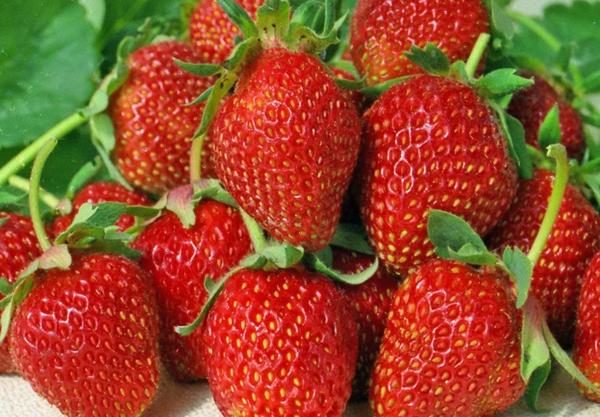
Strawberries and strawberries are different species of the same botanical genus.. It’s impossible to find real strawberries on store shelves, and in the garden it grows only with collectors and breeders. In nature, this plant grows in the southern regions of Russia, Europe and Central Asia. From strawberry garden strawberry has a number of significant differences:
- Strawberry fruits are much smaller, more rounded, their color is closer to purple-magenta, and not to red.
- Fruits and flowers of strawberries are taken out on the shoots above the leaves., and strawberries are located at the bottom.
- Strawberry fruit difficult to separate from bracts.
- Flowers strawberry dioecioustherefore, very few fruits form on the bushes.
The taste and aroma of strawberry and strawberry fruit is expressed, as a rule, equally well.
How to choose a variety for cultivation in the garden?
Choosing a variety of garden strawberries for planting, you must first decide on the type of fruiting. Ordinary plants bloom and give the crop once per season. Repairers bear fruit during the entire growing season.
All summer, having a fresh berry on the table is a tempting prospect. But repair grades, apart from their merits, have some disadvantages:
| Benefits | disadvantages |
|---|---|
| Fruiting whole vegetative season
High yield Saving space on the site (there is no need to keep several varieties with different ripening period) |
Lower frost resistance
Great need for fertilizer and irrigation Early aging of the bush associated with the depletion of the plant's generative resources |
The second important point when choosing - the appointment of the fruit. It is necessary to decide for what strawberries will be grown: for fresh consumption, for preservation or for sale.
Fragrant varieties
Among the varieties with excellent dessert taste and aroma can be noted:
- Deroyal;
- Kimberly;
- Lambada;
- Polka;
- Wim Tard;
- Mize Schindler;
- Pineberry
- Strawberry garden Mize Schindler
- Strawberry Pineberry
- Strawberry Garden Polka
- Strawberry garden Wima Tarda
- Strawberry garden Deroyal
- Strawberry Kimberley
- Strawberry Lambada
Berries for preservation and freezing
Strawberries to be used for preservation or freezing, should have a denser consistency. For this purpose, suitable varieties:
- Vima Zanta;
- Kent;
- Susie;
- Tago;
- Totem;
- Kamarose;
- Evis Delight
- Strawberry garden Wima Zanta
- Strawberry garden Kamarosa
- Strawberry garden Kent
- Strawberry Tago
- Strawberry Garden Totem
- Strawberry garden Evis Delight
Best repair grades
For sale it is better to take exactly remontant or photo-neutral varietiesthat can give the crop to the maximum. In addition, the fruits of such strawberries should be well kept and transportable. For example:
- Mara de Bois;
- Queen Elizabeth II;
- Diamond;
- Albion;
- Evie 2;
- Victoria.
- Strawberry garden Diamond
- Strawberry Garden Queen Elizabeth II
- Strawberry garden Albion
- Strawberry garden Mara de Bois
- Strawberry garden Evie 2
Other factors that need to be taken into account when selecting a variety of garden strawberries are ease of care and resistance to weather conditions. If it is not possible to spend a lot of time on the beds and take care of the bushes, preference should be given to bezeless varieties. In regions with severe winters It is important to choose frost-resistant strawberries. In a humid climate A serious argument is resistance to fungal infections.
How to prepare planting material?
For the successful cultivation of garden strawberries is not enough to buy a good variety and plant it on the garden. Seedlings before planting need to properly prepare:
- Inspect the bushes, reject the sick and the weak, with poorly developed apical kidney.
- Roots cut up to a length of 7-10 cm.
- For 2 hours place the roots in a solution of the drug "Fitosporin-M". This will protect seedlings from a variety of fungal and bacterial infections.
- Powder roots powder root stimulator ("Kornevin" or "Heteroauxin").
Instead of stimulants, you can use the old "old-fashioned" method and cook clay talker: in 10 liters of water dilute the clay to the consistency of liquid sour cream and add 1 kg of well-rotted manure. Strawberry roots are dipped into this solution, dried for half an hour and planted in well-moistened pits.
Propagation of strawberries with mustache and horns, planting and care
Most garden strawberry varieties are easy throws air slips - mustache carrying young rosettes. If you want to multiply your favorite variety, choose a strong fertile bush and leave 3 tendrils on it. Without separating the daughter outlet from the mother bush, it is fixed to the ground, instilled and watered. If the layering has a continuation of the outlet, it pinch.
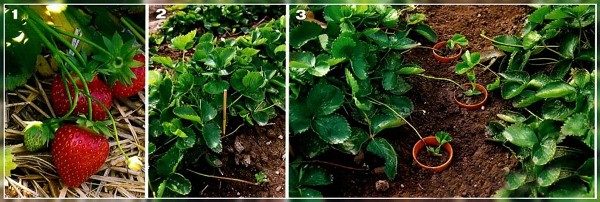
On rooting usually takes about a month. After the young plant has stuck, it is separated from the parent bush, dug and transferred to a permanent place.
If the variety does not give a mustache, you can propagate it by dividing the bush - the so-called "horns." The horns are rosettes formed on a common royal rhizome.. The older the strawberry bush, the more it can have horns.
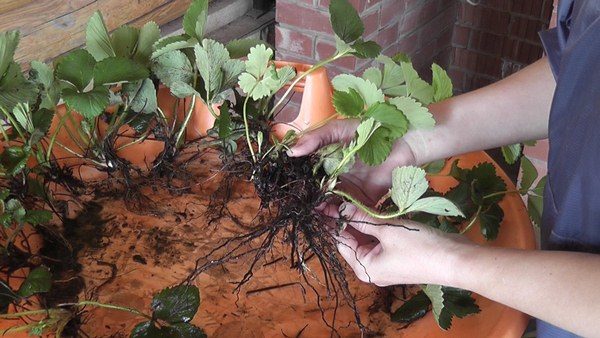
Shrubs are usually divided in spring. The plant needs to be dug up and lowered by roots in a basin with water. After washing off the ground, the bush is examined and a knife is separated by one socket with a section of rhizome.. As a rule, strawberries are divided very easily, and you can even do without a knife. Subsidiaries immediately planted in a permanent place.
Diseases and pests, prevention in spring and autumn
Even pre-treatment of seedlings with fungicides does not protect strawberries from disease for life. The plantation may be affected by some viral infections that are carried by aphids.:
- Xanthosis. Young leaves and rosette center lose chlorophyll and turn yellow. The leaves become shallow and curl upwards, strongly shortened scapes form.
- Rugosity. Pale spots appear on the leaves.In these areas, the growth of tissues stops, the leaf bends and becomes wrinkled.
- Greening petals. The corolla of the flower is formed by small, with greenish petals. Fetching fruits dry, not having time to ripen, the plant dies.
- Verticilous wilting. The leaves turn pale, are stunted, the plant takes on an oppressed, flattened appearance. The plant can die in a few days (lightning form), and in 2-3 years (chronic form).
- On the bush strawberry develops wrinkles
- Verticilous wilting of garden strawberries
- Garden strawberries hit by xanthosis
The main preventive measure against the spread of strawberry diseases at the site is to cultivate varieties that are immune to them.. Sick plants should be immediately removed and burned. It is very important to deal with pests in a timely manner.
In addition to aphids, strawberries and moths, weevil, raspberry-colored beetle, green bug, wireworms, nematodes can affect the spiderweed and strawberry mite. For prevention in the spring before flowering it is necessary to carry out the treatment with drugs "Horus" or "HOM"
Weekly watering and occasional watering can help prevent fungal infections.spraying a strawberry plantation with a solution of Fitosporin-M.
Protection of strawberries from heat and frost
Strawberries planted on a bed can suffer from the sun until they take root and become effective. It is necessary to pritenyat. You can build a screen from a special sunscreen mesh. Some fruit growers simply cover the planting with an inverted plywood box.
In the summer heat, it is important to prevent the soil drying under strawberries.. The best way is mulching. As mulch is used as all sorts of organics, and black agro-textile, which allows air and water to pass through.
In central Russia and in the south, strawberries normally winter without a special shelter. It is enough to sprinkle a peat layer or sawdust for the winter. In colder regions, it is better to additionally place an arc over the bed and cover it with 2-3 layers of thick agrospan over the autumn.
Conclusion
Garden strawberries - culture, easy to cultivate in their personal plots. It easily reproduces, has many varieties for every taste and for any purpose.. With some effort to protect planting from diseases and pest invasion, you can get a big return on the crop. And if you build racks for vertical or pyramidal placement of strawberry bushes - also save space. Not to mention aesthetic pleasure.
